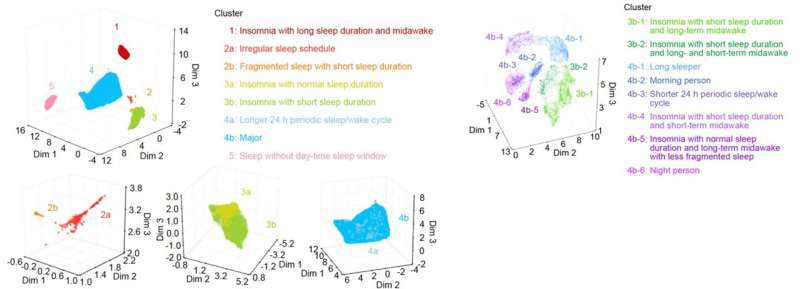Classification of 16 adult sleep patterns based on large-scale sleep analysis

In recent years, the number of people worldwide who are dissatisfied or anxious about their sleep has been increasing due to the diversification of lifestyles. Simple sleep measurement and quantitative understanding of individual sleep patterns are very important not only in the field of healthcare but also from the medical perspective, such as in the diagnosis of sleep disorders.
A research group of The University of Tokyo led by Professor Hiroki Ueda (also a Riken team leader) and Machiko Katori, and Assistant Professor Shoi Shi (RIKEN) used ACCEL, an original machine learning algorithm developed by their research laboratory, to determine sleep and waking states based on arm acceleration and converted the acceleration data of approximately 100,000 people in the UK Biobank into sleep data, which was then analyzed in detail. In their study published in Proceedings of the National Academy of Sciences, they found that the sleep patterns of these 100,000 people could be classified into 16 different types.
The research group first focused on the arm acceleration data of approximately 100,000 people in the UK Biobank. This data was obtained from men and women in their 30s to 60s, mainly in the UK, who were measured for up to seven days using wristband-type accelerometers. Using an algorithm (ACCEL) they had developed in 2022, the research group generated sleep data for approximately 100,000 people from the acceleration data.
The obtained sleep data were converted into 21 sleep indicators, and then, using dimension reduction and clustering methods, the sleep patterns were classified into eight different clusters. These included clusters related to "social jet lag" and clusters characterized by mid-onset awakenings and considered insomnia, enabling the extraction of clusters related to lifestyles and to sleep disorders.
Next, in order to examine sleep patterns associated with sleep disorders in more detail, the research group focused on six of the 21 sleep indicators, including sleep duration and intermediate waking time, which are known to be closely related to sleep disorders. By applying the same analysis to data where one indicator deviated significantly from general sleep (data in the upper 2.28th percentile or higher or the lower 2.28th percentile or lower in the overall distribution), they were able to classify the data into eight clusters. These included clusters related to morning-types and evening-types. They also identified several clusters associated with insomnia, and were able, along with the clustering using the entire dataset, to classify seven types of sleep patterns associated with insomnia.
Thus, by analyzing sleep on a large scale, they have revealed the landscape of human sleep phenotype. This study has made it possible to quantitatively classify clusters related to lifestyle such as "social jet lag" and morning/evening types, which are usually difficult to determine with short-term PSG measurements, In addition, detailed analysis of outlier and classification of sleep patterns revealed seven clusters related to insomnia. These clusters are classified based on new indicators differing from conventional methods, and are expected to be useful in the construction of new methods in terms of diagnosing insomnia and proposing treatment methods.
More information: Machiko Katori et al, The 103,200-arm acceleration dataset in the UK Biobank revealed a landscape of human sleep phenotypes, Proceedings of the National Academy of Sciences (2022). DOI: 10.1073/pnas.2116729119

















